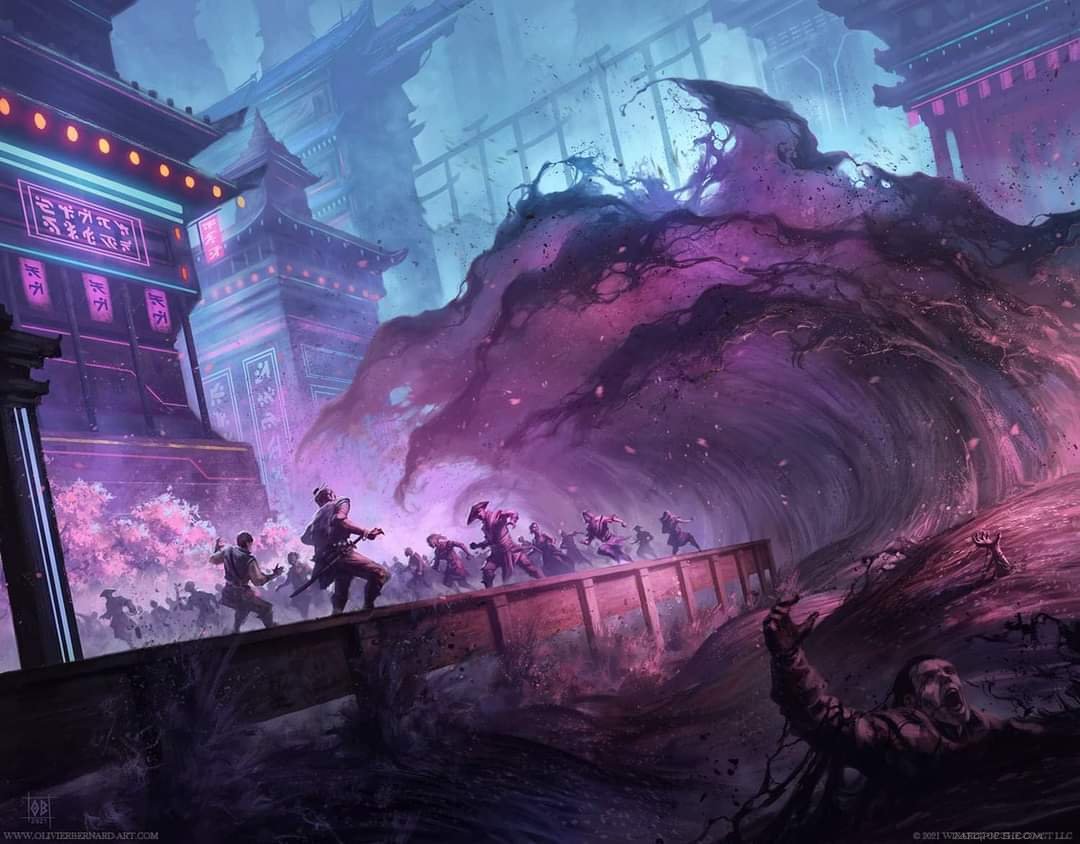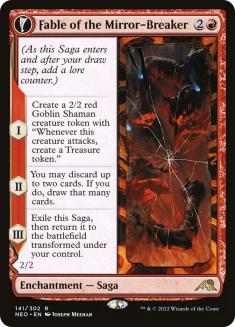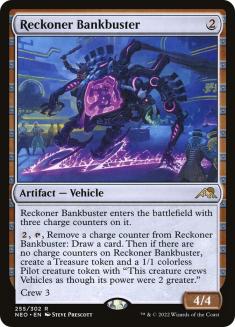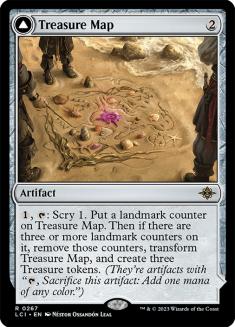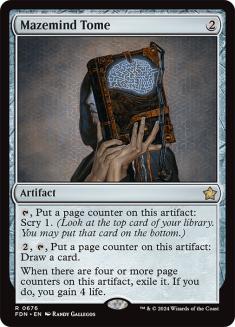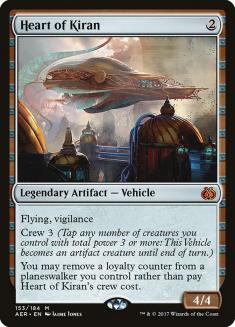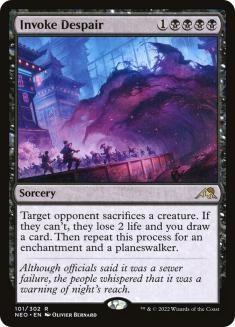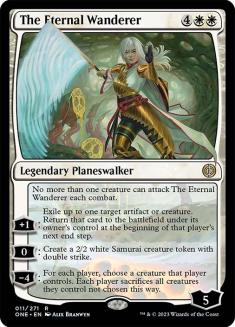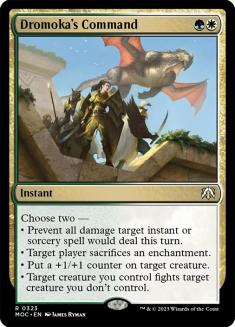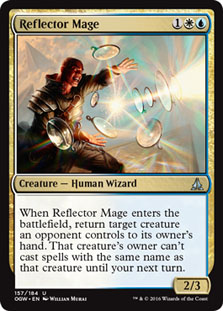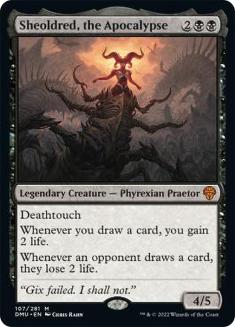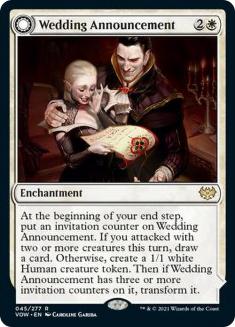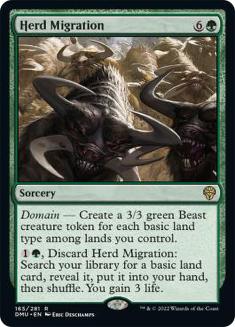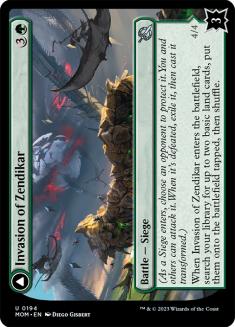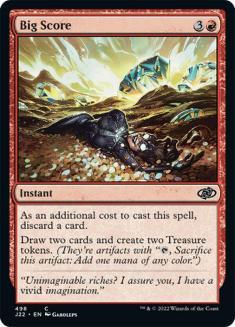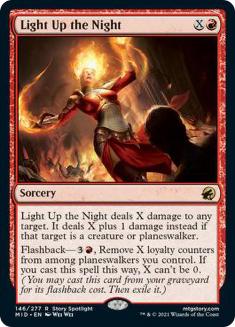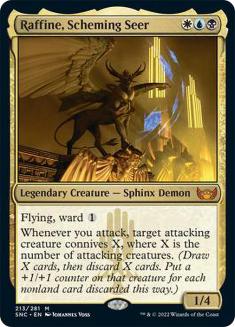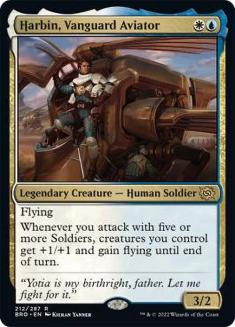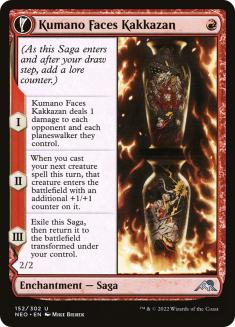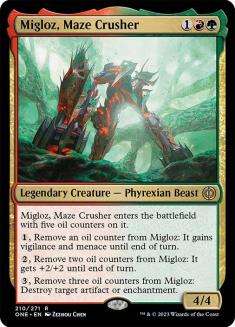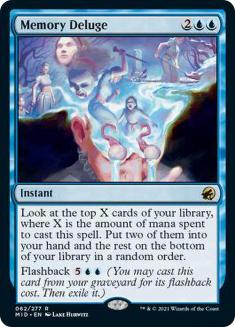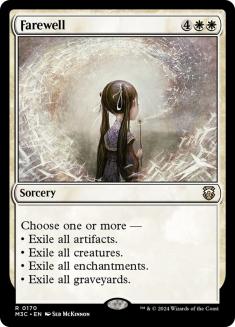It’s good to be back. After a period of impromptu Banned and Restricted announcements – usually on Monday afternoon after a hearty lunch in Renton – we are back to the old system of scheduled banning announcements featuring a big banning ‘event’ in the summer and the option for emergency bans in the weeks after set releases. This will mean less ban discussion throughout the year, but a much heavier focus on possible bans as the season approaches.
This week’s inaugural announcement was a glimpse into that future. It took a big swing at some obvious problems that couldn’t just leave with the rotation that would have come in a few months under the old schedule.
Banned: Fable of the Mirror-Breaker
This one was easy to call. There was such a strong consensus that Fable of the Mirror-Breaker would and should receive a banning that the only question was why it took this long. Fable did enough things and did them well enough that it was an automatic inclusion in red decks of every stripe, and the flexible mana in Standard made it tempting to splash red solely or primarily for Fable.
This broad package was just what you want in a deck like Rakdos Midrange that aims to dabble in everything, but Fable is even more essential in decks that lean on some specific aspect of the card. In Pioneer and Modern, a proactive threat that fixed your draws and created a creature without being one itself is perfect for decks like Indomitable Creativity. Here in Standard, Rakdos Reanimator needed the second chapter of Fable as a discard outlet that set up your reanimation plan while doing enough that it also made you less reliant on reanimation.
Rakdos Midrange will be worse without Fable, but there are enough generic midrange cards that it can probably regroup. Rakdos Reanimator might just vanish entirely. Fable doing a little bit of everything meant that it was the ideal enabler for whatever offbeat thing you were trying to do; the decks with the most distinct personalities will suffer most from losing Fable.
Fable: A Benevolent Tyrant?
A larger concern about the Fable ban is that people might have unrealistic expectations of what comes next. Most formats have a ‘best card’ or several cards that are a cut above everything else, and Fable is one of the most benevolent cards in recent memory to hold that title. It’s easy to remember Bonecrusher Giant squeezing out every small creature or Oko, Thief of Crowns blurring every card and game into one long, miserable experience.
Fable is just the opposite – it enables other cards well, and there’s nothing that’s off-limits because of Fable. Games where one person has Fable and the other doesn’t can feel like they are all about Fable, and the card is much better on the play than on the draw in a way that creates some frustrating play patterns – but that’s Magic these days. It’s too early to say what Fable’s successor will be, but there’s no guarantee that it will be better to play with or against.
Banned: Reckoner Bankbuster
We received a preview of the next banning when Reckoner Bankbuster and Fable quietly vanished from the deals in the MTG Arena store, but this outcome was no surprise. Bankbuster also took a while to catch on and its power isn’t as obvious as Fable’s, but there was already some encouraging precedent.
Treasure Map and Mazemind Tome are clear ancestors of Bankbuster that overperformed when given a chance in their respective Standard formats. Treasure Map often appeared alongside heavy-hitters like Niv-Mizzet, Parun or as a sideboard pivot for red decks looking to go larger when their aggressive plans were weak. Mazemind Tome only appeared in slower decks, but it gave them the filtering and eventual lifegain to keep up against aggro, and the flow of extra cards over time put you far ahead against other slow decks.
Reckoner Bankbuster is a worthy successor to these effects, but that style of card advantage is less impressive in a world where everyone has a pile of Fables or Wedding Announcements churning out more cards and game objects every turn. Bankbuster’s unique selling point was its flexibility, and a comparison with a very different card makes that point clear.
The Heart of the Matter
Mazemind Tome does its one task very well – but it never attacks for four! Treasure Map is the ideal bridge to your late-game plays, but that’s all it can be. Reckoner Bankbuster is a hard-hitting threat as early as Turn 3, giving slower decks the dream of aggressive starts that can put unexpected pressure on the opponent.
Creatures (14)
Lands (26)
Spells (20)

Take David Olsen’s Five-Color Ramp list from the Top 8 of Pro Tour March of the Machine – a deck aiming to chain Etali, Primal Conqueror or Atraxa, Grand Unifier into Herd Migration can also curve Bankbuster into Topiary Stomper and do a fine impression of an aggro deck. Here, Bankbuster looks like Heart of Kiran, the backbone of these aggressive midrange decks for years – but Heart of Kiran won’t draw you three cards, either!
A clear trend that emerged at the Pro Tour was savvy Rakdos Midrange players treating their Bankbuster primarily as an attacker. The life loss from Graveyard Trespasser; Sheoldred, the Apocalypse; Invoke Despair; and the Light Up the Night + Chandra, Hope’s Beacon combo made it easy to turn the corner quickly and win games out of nowhere.
A card this flexible with no colour requirements inevitably becomes an easy default for almost any deck, from aggro and midrange to control and ramp. I don’t think Bankbuster was a necessary banning, but removing it forces deckbuilders to make more choices and lowers the bar that newer cards like it have to clear.
Banned: Invoke Despair
By contrast, this announcement’s final victim has as strict a mana requirement as you’ll ever see. Black midrange of some form has been a force in Standard since the last rotation, and Invoke Despair was an important figurehead for it.
A five-drop that’s this hard to cast should give you a good payout in return. Invoke Despair isn’t too powerful in the abstract, but in the context of black’s current dominance and historic weaknesses, it stands out more. The explanation is worth a look:
The Enchantment in the Room
There’s an unaddressed point about enchantments here. For 30 years, the colour pie has given black and red a glaring weakness to enchantments. It’s only recently that black has received any answers to them, let alone good ones – and this was forced by enchantment themes in sets like Theros Beyond Death and Kamigawa: Neon Dynasty. Powerful enchantments like Wedding Announcement would normally be totally indestructible against a deck like Rakdos Midrange, which isn’t great for gameplay. If Invoke Despair marks too big a swing in the other direction, that’s bad too – but it’s not clear where the happy medium is.
Many of the decks with important enchantments have a lot of more expendable enchantments as a buffer against Invoke Despair – the Ossification that devoured a Fable token has done its job and can take one for the team. Planeswalkers are harder to protect this way, and the popularity of Invoke Despair is a big reason that flashy planeswalkers like The Eternal Wanderer haven’t seen much play. Chandra, Hope’s Beacon did break through – but that’s one of the best cards to pair with Invoke Despair!
In this regard, Invoke Despair is similar to other cards – including fellow Hall of Shame member Reflector Mage – that traded with their targets so well that they effectively banned entire card types. The enchantment hoser mode of Dromoka’s Command rarely came up, but only because Command’s popularity drove out most enchantments. Any expensive creature that didn’t offer immediate value was unplayable in the face of Reflector Mage. Teferi, Time Raveler infamously locked out not only that style of creature, but also most reactive cards or spells like Finale of Promise that its static ability shut down.
Now, let’s look at some Standard standouts that survived this massacre.
Survived: Sheoldred, the Apocalypse
As a known Sheoldred sympathizer, I’m glad that it is the heir apparent to the title of best card in Standard. I understand the frustration that many people have with the card, but it’s rare that one of these Baneslayer-esque creatures is actually on top. If not Sheoldred, one of the many Fable imitators in the format will step up instead.
Survived: Wedding Announcement
Wedding Announcement was the closest comparison for Fable before and is a proven force in Standard, but its unique selling point was its strength against black midrange. If that means less now, both Announcement and its obvious homes like Mono-White Control will lose traction – especially if people are going much bigger, much faster.
Survived: Five-Color Ramp Tools
The Five-Color Ramp decks that rose up to fight Rakdos Midrange lose their natural prey, but may just be the apex predator now. They now have to strike a delicate balance between preparing for this ramp arms race and avoiding the aggro decks stealing the win before that race has even begun.
Survived: Chandra, Hope’s Beacon and Pals
Big Score and Chandra, Hope’s Beacon are a match made in heaven, and that partnership has more room to flourish in Standard now. Chandra’s synergy with Light Up the Night was one of the big stories of Pro Tour March of the Machine, and we haven’t seen the last of it yet.
Survived: Raffine, Scheming Seer
Esper Legends was arguably the best deck before the release of March of the Machine, and it survives totally unscathed. There’s not much to say here that you don’t know already – this was and is a great deck, and the first litmus test for any new deck hoping to join Standard.
Survived: Azorius Soldiers Cards
Azorius Soldiers just about held its own, even in a Rakdos-heavy format, and there are various aggro decks ready to strike if the format forgets about them. Black midrange didn’t lose any of its best cards against aggro – Cut Down into Bloodtithe Harvester into Graveyard Trespasser is still a scary curve – but it will be stretched thin between answering aggro, ramp, and maybe even the occasional control deck…
Survived: Control Powerhouses
Reckoner Bankbuster was much better against control than for it, and it was tough to answer a resolved Fable cheaply. With these menaces gone, classic control may have another chance to shine. Memory Deluge is one of the best control tools of all time, but it existed without the right support in a hostile format. Maybe Shaheen Soorani will have cause to celebrate now!

